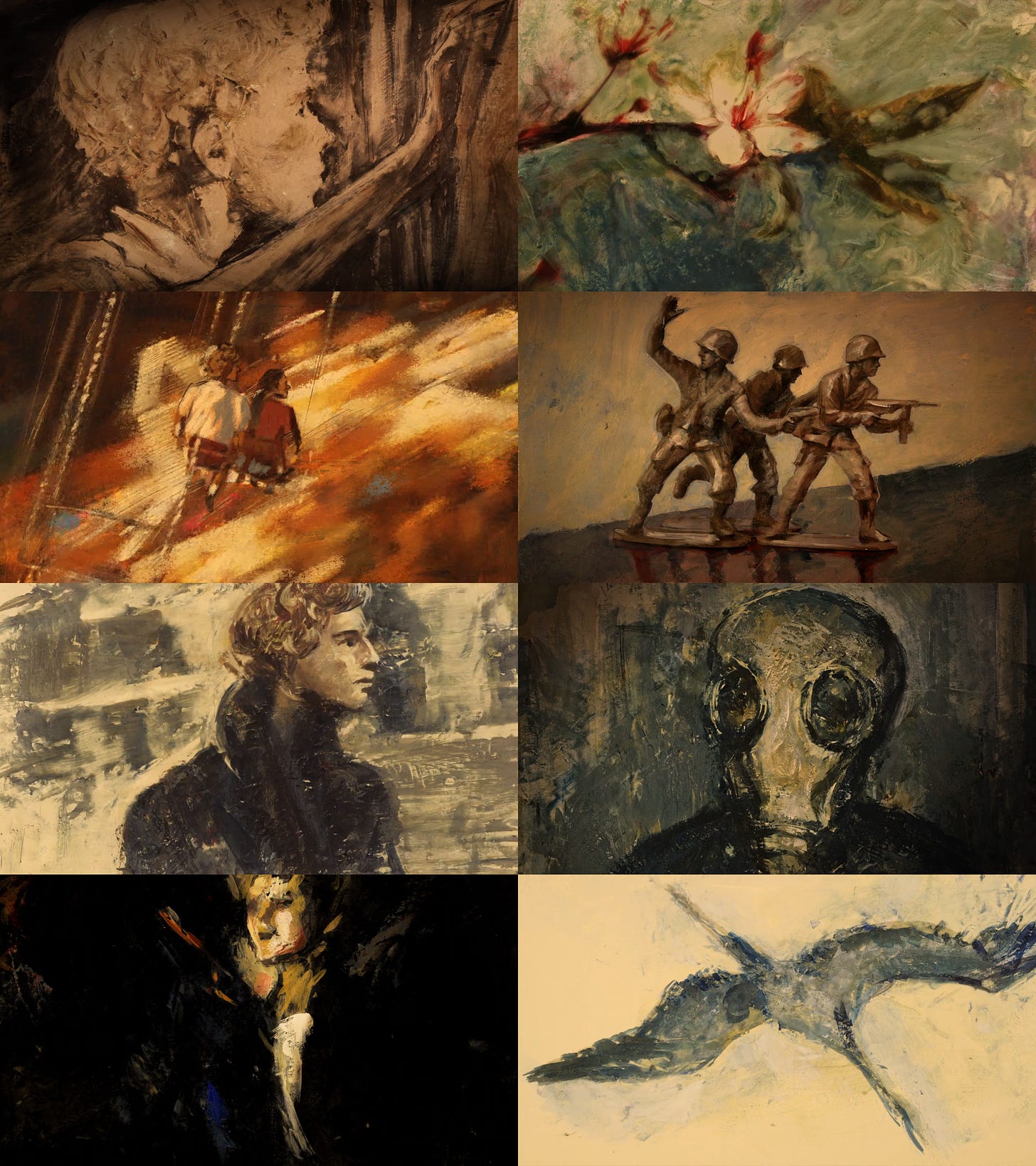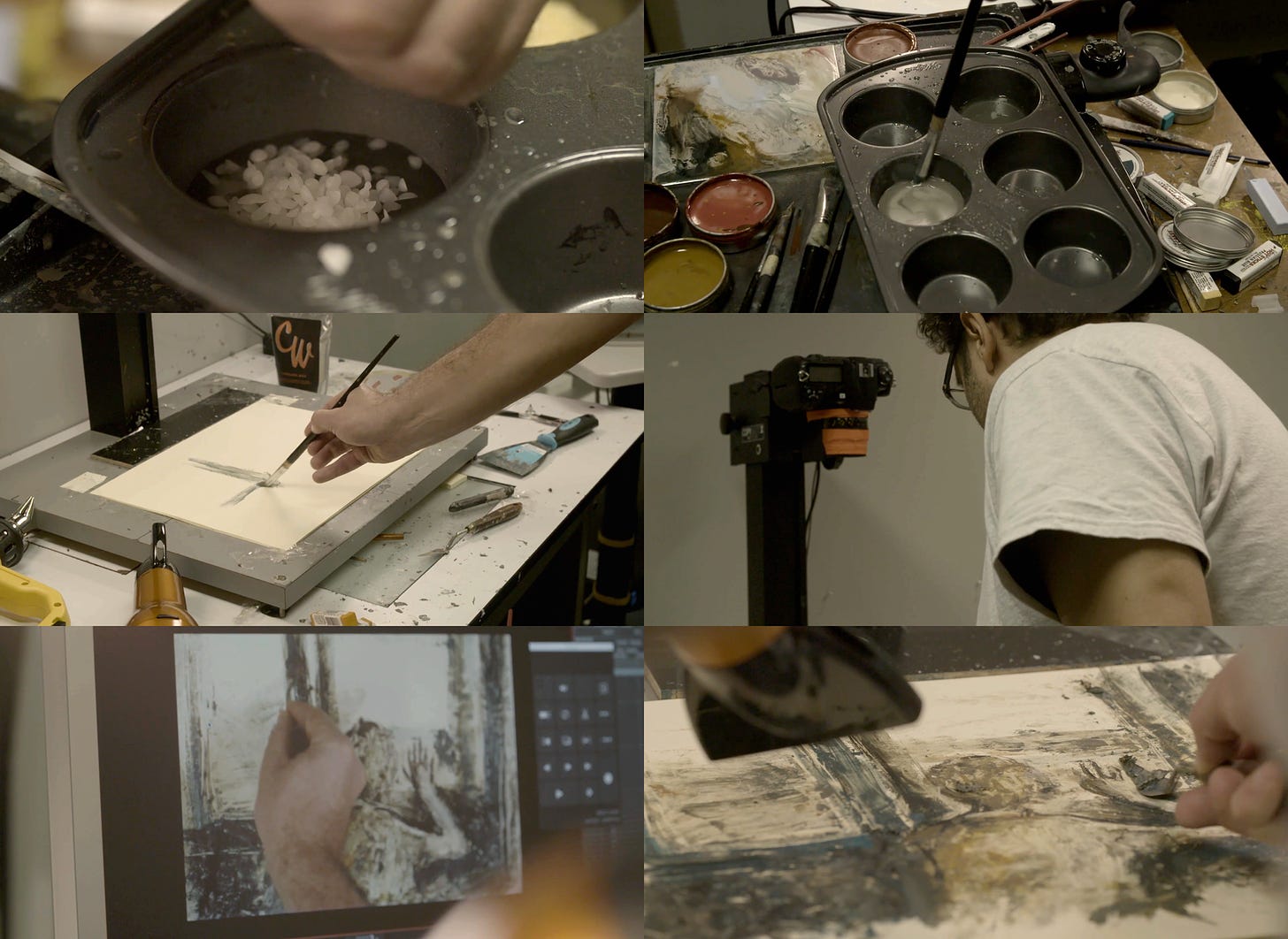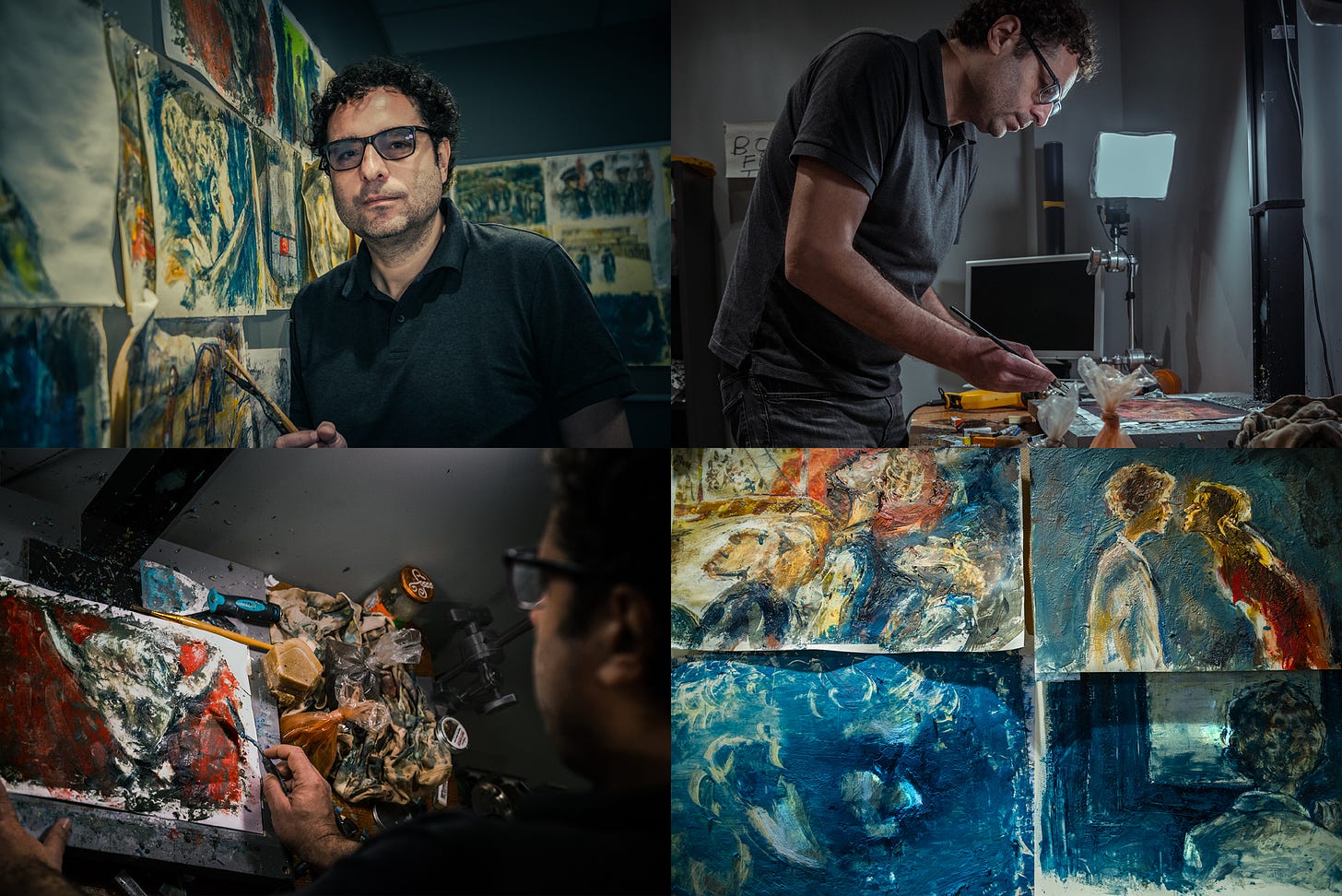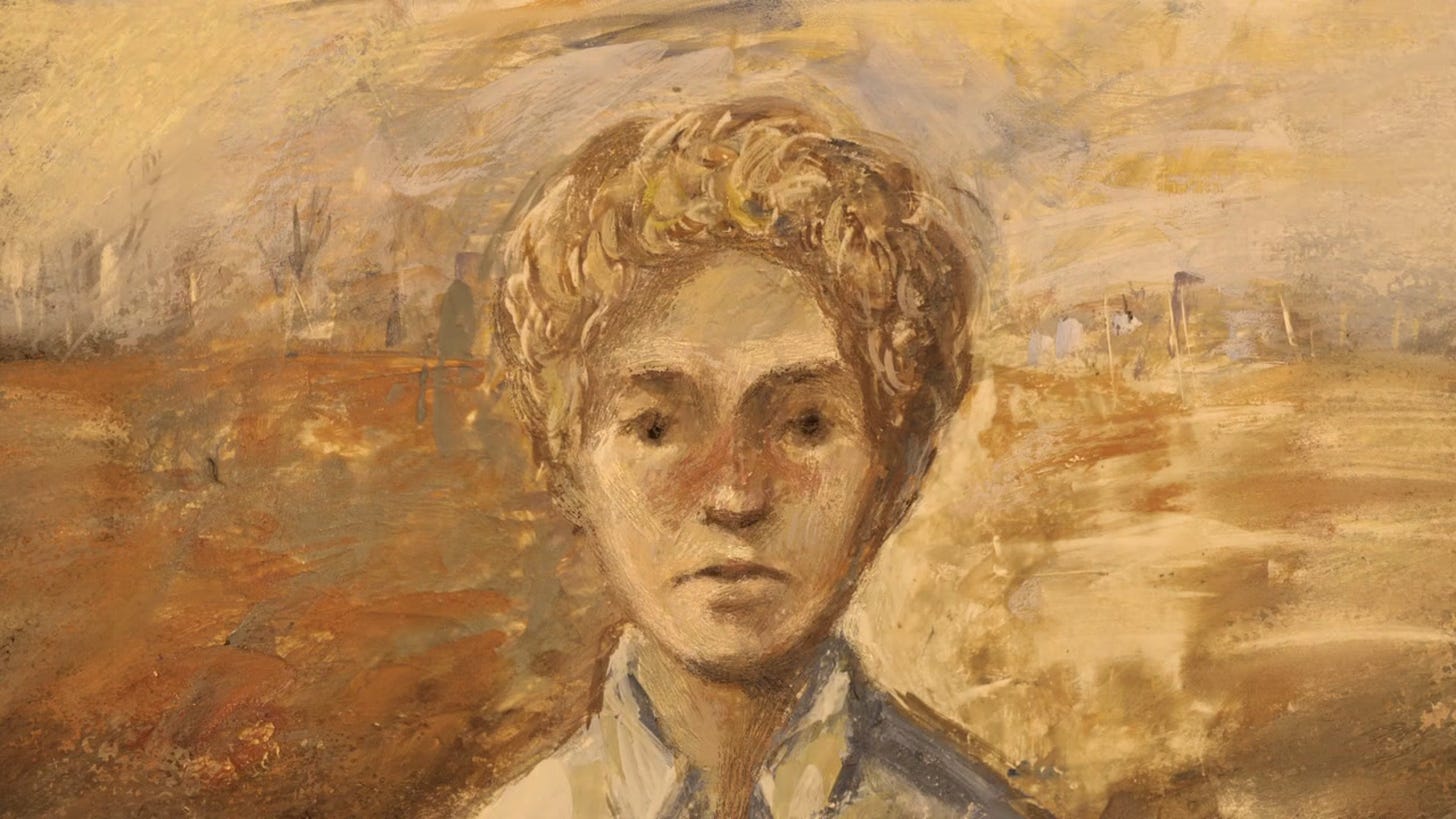Welcome back! And a special hello to our new paid subscribers. We hope you’ll enjoy our Thursday issues.
Substack recently made it possible for readers to send personal messages when they pay to subscribe, and the ones we’ve been getting have overwhelmed and humbled us. Right now, Substack’s tools don’t let us reply — but, to everyone who’s sent one, please know that we’ve read it and that it means the world to us. Thank you so much.
Now, let’s start into our topic today. It’s one of our favorite animated films of the past five years, which we’ve been haunted by since we first saw it: Theodore Ushev’s The Physics of Sorrow (2019).
The film won over the festival circuit, taking the Cristal at Annecy 2020. It’s easy to see why. This is a personal story of memory and myth and time, and of the little objects — toy soldiers, gum wrappers — that connect people to them. It’s also, in a sense, about the end of the world. A troubled Bulgarian man, who grew up in the USSR and immigrated to Canada, tells a tale about his life that consistently cycles back on itself.
Ushev chose to paint The Physics of Sorrow, and the imagery he pulled out of his paints is intense and evocative. But, despite the heaviness of the story, the film wasn’t torture to make. He told CBC Radio that it’s “called The Physics of Sorrow … [but it] was a pure happiness for me.” It was a long road that he was glad to walk.
Today, we’re discovering the reasons for Ushev’s happiness, and how he came to make this beautiful film. Here we go!
The Physics of Sorrow was born in 2011, but it wasn’t a film then. It was a novel by a man named Georgi Gospodinov. His book chronicles modern Bulgarian history in a non-linear swirl of memories and details, lifetimes and disappearances — and the contents of time capsules.
It became a sensation. Theodore Ushev was among its readers.
He came to it shortly after its release. “It had already kind of a cult status in Bulgaria, as something different, modern, out of the recent Bulgarian tradition,” Ushev said. When he finally picked it up, he devoured it: “it was a book about me, about my generation.”
He and Gospodinov are the same age. They’re both Bulgarian Gen Xers born in 1968, the year when the Soviets crushed the Prague Spring. They felt the same hopes and losses, and lived to see the USSR fall. “I read the book … in one night,” Ushev recalled. “The next morning, I had the film in my head.” He had to speak with Gospodinov.
A mutual contact put them in touch, and, right away, the pair clicked.
Both of them were well into their careers as boundary-pushing artists — Gospodinov as a poet and author, Ushev as an animator at Canada’s state-funded National Film Board. Like Gospodinov later said:
Theo is from Kyustendil, I am from Yambol — both small towns. The connection between us came along The Physics of Sorrow. When the book came out, Theo wrote to me... There are times when you read something and somehow know that you will be able to understand this person in half a word.
He quickly gave Ushev permission to adapt the book. It was the start of an eight-year journey, including six or seven long, challenging years of animation.

Ushev is known for changing his style. “I never use a technique more than once,” he’s said. He started with the NFB around 2003 (having moved to Montreal in the late ‘90s) and has innovated since then, adapting his methods to each film’s core idea.1
He’s someone who believes that the medium is the message. “What you want to say always depends on the medium you use,” Ushev argued in 2018. For The Physics of Sorrow, he chose encaustic painting, in which pigment is mixed with hot beeswax. Ancient Egyptians used it — the paint doesn’t fade like oils. It can last for millennia.
Ushev put it this way:
Using encaustic painting was not a random choice. The first time capsules were the Egyptian tombs and coffins. They would place everyday objects alongside the buried person, with an encaustic portrait on the cover. Encaustic painting was the first technique used to create realistic portraits of the dead on Egyptian sarcophagi, thus allowing the memory of the buried person to be preserved over centuries. With The Physics of Sorrow, I wanted to create a sarcophagus of my generation.
The result is a dark, rough, expressionistic painting in motion. There’s a temptation to compare it to the animated paintings of Alexander Petrov, another Eastern European artist whose Old Man and the Sea was similarly made in Canada. But the styles and spirits are different, and maybe opposed. Ushev once attacked Petrov’s My Love (2006) as “kitsch,” accusing it of playing into the Putin regime’s cultural agenda.2
Not that The Physics of Sorrow is art for art’s sake. Ushev had an agenda of his own. “I see my films as propaganda posters on the wall … This is the propaganda of the human spirit,” he said. Even the impressive style isn’t the point: his hope is that the viewer “forgets about the technique and dives into the story and the emotions.”
This is what makes the film so hard to stop watching. Its story is a stream of consciousness, full of sharp turns and unlikely associations between myth, history and memory. A Bulgarian basement is the labyrinth of Crete — a gas mask is the Minotaur’s face. Ushev was trying to tell a “memory maze” of a story. But even the most enigmatic scenes make a kind of sense by the end.
The Physics of Sorrow slowly reveals itself as an accessible film built in an unusual way. A story about one person’s life and sadness, but also about a whole era. There’s deep power in the writing, which was partly Gospodinov’s and partly new.
Ushev freely swiped and recontextualized lines from the novel — creating a new version of Gospodinov’s story by blending the original with his own memories and those of people he knew. The result was, Ushev said, his “most personal film to date.”
Many key scenes and characters from the film — Major Batsanov, the acrobat girl, the disco dance to a Men Without Hats song — aren’t exactly in the book. The gas mask imagery is there, but it takes on greater significance in the film. “My goal was to create a new work of art,” Ushev told Variety.


Basically, Ushev wanted to capture the style of the novel instead of its literal events. Gospodinov gave him tips along the way, which sometimes made it into the film and sometimes didn’t. But he was happy to let Ushev work. As the author explained:
There is something very nice that, I think, Miron Ivanov, a forgotten writer, once said: “The greatest thing about Notre Dame — its construction took around 400 years — is that for four centuries these people were in the same opinion. Several generations to pass on to each other the little they have done, not to quarrel, not to tear it down ... This is how cathedrals are built.”
Even so, Ushev was nervous about showing his work to Gospodinov. He was standing on a giant’s shoulders. He felt similarly about working with the NFB. Here’s what he said in 2019:
When you go there, in the studios, you can kind of feel the ghosts of Norman McLaren and Arthur Lipsett and all the big filmmakers from the past century. And, well, it is my duty to follow their steps — not to follow them artistically, but to do better film and better film and better film, and that’s what I was trying to do with all the help of the beautiful people over there.
The animation work on The Physics of Sorrow was all Ushev, though. He animated around 15,000 frames solo, paint on paper. And, as he couldn’t find any previous animated films made with encaustic painting, he had to invent the process through trial and error.
Using a paint recipe he got from his father, an artist himself, Ushev slowly refined his technique. After two or three months, he had it.
It relied on speed. The paint dried quickly and had to be reheated with things like blow dryers. He didn’t have “time to go into details,” which added immediacy to the art. Ushev compared it to painting memories. “Because when you remember a memory, it’s never clear. You lose details, and it becomes blurry,” he told CBC Radio.
He ultimately painted movements rather than still images. Many of the film’s shots only come into existence as animation — an individual frame may look abstract when taken alone, but it becomes clearer when seen in sequence. Each painting builds up the mental impression of what’s happening on screen.
Ushev worked in a windowless room that prevented light variation, and stood at his desk to paint. He would tweak his art and photograph, tweak and photograph. “It was very physically demanding because it was under-the-camera [animation],” Ushev said. “So, you have to be very strong and be in good shape.”3
Eventually, he was able to paint six seconds of the film per day, or around 50 frames. That amounted to eight daily hours of standing at his desk. He worked not just with beeswax and pigment but with things like palm wax, gouache, crayons and paraffin.
“My producer, Marc Bertrand, joked that my studio smelled like a candle workshop or an Orthodox church,” Ushev said to Skwigly. “That was indeed my temple. I wouldn’t be exaggerating if I said those six years of animating the film were the happiest time in my life.”
When you pair all of that with Rossif Sutherland’s performance as the unnamed narrator, and Ushev’s inspired use of classical music and pop songs in the soundtrack, something very special emerges. The Physics of Sorrow (embedded in full above) turns into a different kind of film.
Ushev remembered its first complete screening at the NFB. Supervisors and colleagues gave him a standing ovation — some cried. That’s how things kept going. Although he’d gotten an Oscar nomination for his earlier Blind Vaysha (2016), animated during a break from this project, he said that he’d “never had such a rapturous reception” as the one for The Physics of Sorrow.
It won major recognition not just from Annecy but from TIFF and Ottawa, among others. It was even shortlisted for the Oscar, but tragically wasn’t nominated.
That didn’t seem to surprise Ushev. “I don’t think it’s an Oscar film,” he told the Bulgarian press even before the snub. “I think it’s too complicated for the Academy’s taste. […] It’s too challenging and too experimental to fight through.”
At the same time, it didn’t seem to bother him. “It doesn’t really matter,” he continued. “What matters is that people who watch it are moved.”
See you again soon!
Details about Ushev’s early work with the NFB come from Animators Unearthed: A Guide to the Best of Contemporary Animation (2010).
Ushev made this remark in a discussion on Chris Robinson’s blog in 2007.
Various details on the making of The Physics of Sorrow come from La Presse, CFMZ-FM and Cartoon Brew, alongside the sources linked throughout.




My favourite issues of Animation Obsessive are the ones that introduce me to something completely new to me. I can't wait to watch this with everyone, thanks for the fantastic writeup!
Would love to watch this, great recommendation!